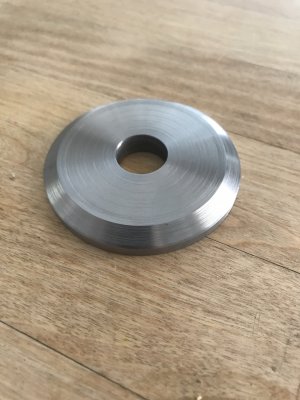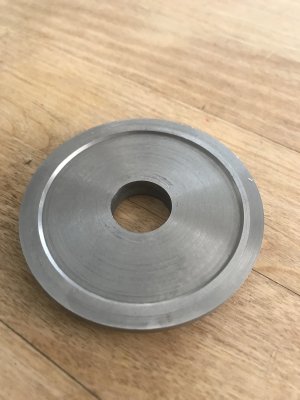-
Scam Alert. Members are reminded to NOT send money to buy anything. Don't buy things remote and have it shipped - go get it yourself, pay in person, and take your equipment with you. Scammers have burned people on this forum. Urgency, secrecy, excuses, selling for friend, newish members, FUD, are RED FLAGS. A video conference call is not adequate assurance. Face to face interactions are required. Please report suspicions to the forum admins. Stay Safe - anyone can get scammed.
You are using an out of date browser. It may not display this or other websites correctly.
You should upgrade or use an alternative browser.
You should upgrade or use an alternative browser.
DavidR8's shop shenanigans
- Thread starter DavidR8
- Start date
Former Member
Guest
Nicely done. I'd worry less about thickness but about Parallelism. As long as the reference back references the same on the lip thats what is important.Took some time off this afternoon to make another arbour washer. Really happy with this one. And it's for a paying customer
They spec'ed a thickness of .30" and I managed to hit .2995" so I'm happy with that.
A44 turns very nicely.
View attachment 25413View attachment 25414
Thanks John, the estimator mentioned three days so at 1600/day that’s $4800 right there. I can’t see three days though. All the prep we talked about is done. So 1 day to paper, wire and parge and another to apply the finish coat seems reasonable to me. I’ll be very curious to see what estimate I get on Monday.
The cost of this little project of yours makes hobby machining look cheap.
Is there a good reason that you can't use vinyl siding or some other less expensive but equally good weather proofing? Even a thick plastic over the old wall and then covered with siding would cost WAYY LESS.
Or how about a mesh backing and flat decorative stone? There are also decorative boards and panels that have artificial stone on them that could be gorgeous.
Why Stucco? My own hand is on the E-Stop button.
Stucco because the rest of the house is stucco. And I'm not confident that a weather-tight seal can be created between siding and the uneven surface of the existing stucco. And as @Dabbler said, we live in rain central. In the winter it rains all the time. Snow is a rarity. So watertight is paramount.The cost of this little project of yours makes hobby machining look cheap.
Is there a good reason that you can't use vinyl siding or some other less expensive but equally good weather proofing? Even a thick plastic over the old wall and then covered with siding would cost WAYY LESS.
Or how about a mesh backing and flat decorative stone? There are also decorative boards and panels that have artificial stone on them that could be gorgeous.
Why Stucco? My own hand is on the E-Stop button.
Stucco because the rest of the house is stucco. And I'm not confident that a weather-tight seal can be created between siding and the uneven surface of the existing stucco. And as @Dabbler said, we live in rain central. In the winter it rains all the time. Snow is a rarity. So watertight is paramount.
Sorry, I can't give up on you. Sheet Rock is pretty darn good stuff and would look great with Stucco.
Lots of other colours and styles. The adhesive is waterproof too.
Google man made rock walls.
Unless they re do then entire wall you are always going to see the repair, the texture from the original is almost impossible to match
@Susquatch idea is worth a thought
@Susquatch idea is worth a thought
@David_R8 - I got interested in why Stucco is a superior weatherproofing product.
What I found suggests it actually isn't. But most people think it is. Invariably it does leak and it actually absorbs water. It depends on a good waterproof barrier behind it. At least that is what I read.
Here is a good representative quote "Stucco is the most common exterior cladding here in Southern California. Properly installed, it’s tough, durable, and attractive. But it’s not waterproof. No matter how skilled the plasterer is, rain will get behind stucco."
GIve how expensive Stucco is, I would strongly encourage you to look at other alternatives. You might even save enough coin to visit me in Ontario or buy some really cool tools!
What I found suggests it actually isn't. But most people think it is. Invariably it does leak and it actually absorbs water. It depends on a good waterproof barrier behind it. At least that is what I read.
Here is a good representative quote "Stucco is the most common exterior cladding here in Southern California. Properly installed, it’s tough, durable, and attractive. But it’s not waterproof. No matter how skilled the plasterer is, rain will get behind stucco."
GIve how expensive Stucco is, I would strongly encourage you to look at other alternatives. You might even save enough coin to visit me in Ontario or buy some really cool tools!
The BC solution (in most but not all municipalities) now involves "rain screen", which provides an evaporative gap between the stucco and the supporting wall. Cladding tech just gets more and more complex.Here is a good representative quote "Stucco is the most common exterior cladding here in Southern California. Properly installed, it’s tough, durable, and attractive. But it’s not waterproof. No matter how skilled the plasterer is, rain will get behind stucco."
Former Member
Guest
Based on the recent posts....
One of the things I learned in the high end window industry (yes one of the top products) was that the biggest issue with stucco was improper drainage which causes rot (nothing new here) but this also raises concern with the repair.
The second concern is do you have other hidden issues in the rest of the house that are yet undiscovered. I would consider a examine of the rest of your house before is in order before going down the rabbit hole, if you are going to invest at least know how much pain there is.
One of the things I learned in the high end window industry (yes one of the top products) was that the biggest issue with stucco was improper drainage which causes rot (nothing new here) but this also raises concern with the repair.
The second concern is do you have other hidden issues in the rest of the house that are yet undiscovered. I would consider a examine of the rest of your house before is in order before going down the rabbit hole, if you are going to invest at least know how much pain there is.
Our house was built in 1920, it is the original dairy farmhouse. It has a lath and plaster exterior so it's been this way since at least the 50's.
We rewired the entire house 16 years ago and took off all of the interior finishing and found zero evidence of water intrusion.
We rewired the entire house 16 years ago and took off all of the interior finishing and found zero evidence of water intrusion.
Dabbler
ersatz engineer
Having renovated 100+ year old houses in Ontario with my Dad, there's some things about stucco that aren't reflected in many web sites. Stucco *is* a very effective moisture barrier that also breathes if applied correctly with the right cement. I've seen stucco houses with the stucco touching beams for over 100 years that didn't rot them - in Ontario where there are 3 seasons of regular but not excessive rain.
The new techniques of putting a air barrier is an improvement, no doubt - but I think it serves the community best that puts stucco on too thinly, or with more permeable (cheaper) cement).
The new techniques of putting a air barrier is an improvement, no doubt - but I think it serves the community best that puts stucco on too thinly, or with more permeable (cheaper) cement).
Awkwardly, the rain screen came into use in BC after the leaky condo debacle of the early 90's, where a non-breathing polymer stucco was being used. It trapped so much moisture as to cause significant structural issues.I think it serves the community best that puts stucco on too thinly, or with more permeable (cheaper) cement).
So now we get use rainscreen under pretty much any siding tech. Sigh.
Former Member
Guest
Great no surprises (fingers crossed).Our house was built in 1920, it is the original dairy farmhouse. It has a lath and plaster exterior so it's been this way since at least the 50's.
We rewired the entire house 16 years ago and took off all of the interior finishing and found zero evidence of water intrusion.
You never know what you will find in old houses.
When we bought our first house in Stratford, ON . . . we tore out all the original lath & plaster so that we could re-wire and insulate and found a newspaper from 1936 In the attic.
When we bought our first house in Stratford, ON . . . we tore out all the original lath & plaster so that we could re-wire and insulate and found a newspaper from 1936 In the attic.
Last edited by a moderator:
I’ll be very curious to see what estimate I get on Monday.
What became of the second quote?


